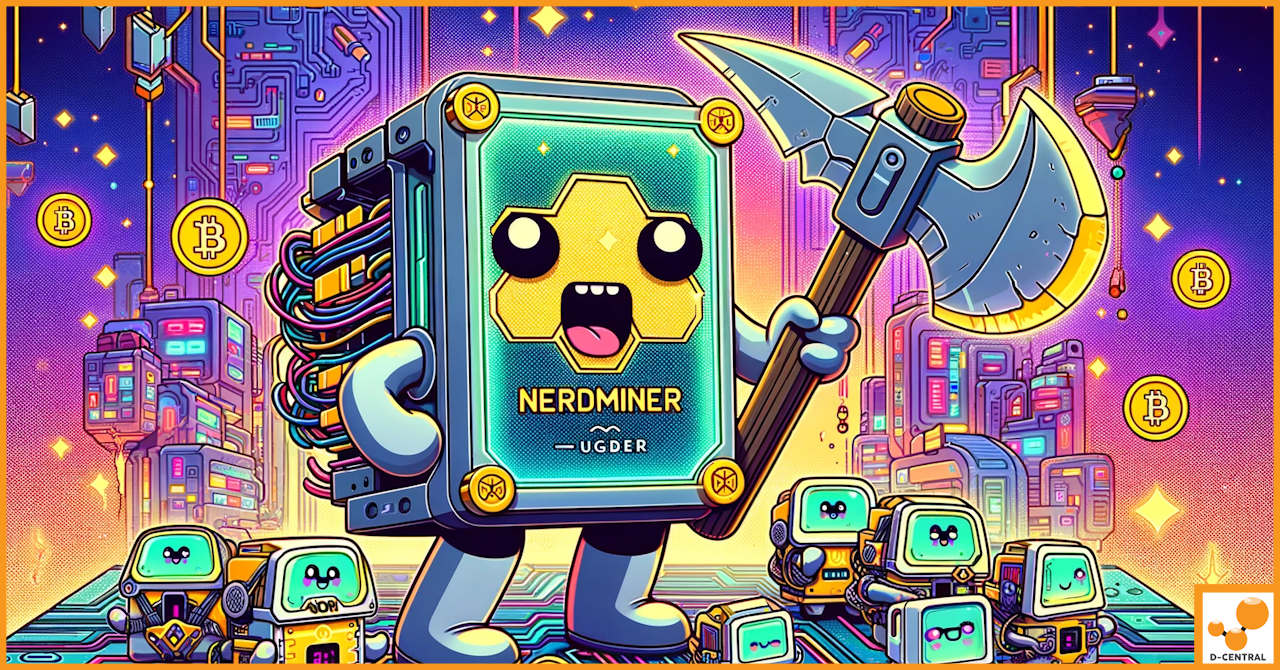
Upgrading From Nerdminer to NerdAxe: Decentralizing Bitcoin Mining on a Grand Scale
Discover how the transition from Nerdminer to NerdAxe is reshaping the landscape of Bitcoin mining, empowering individual miners, and promoting
4479 Desserte Nord Autoroute 440, Laval, QC H7P 6E2

Are you ready to dive into the exciting world of home Bitcoin mining? Before you start, arm yourself with essential knowledge to avoid common pitfalls. In this comprehensive guide, we’ll explore the top 10 mistakes newcomers make and provide expert insights to set you up for success.
One of the most critical mistakes newcomers make when venturing into home Bitcoin mining is failing to conduct thorough research. The cryptocurrency landscape is complex and ever-changing, making it essential to arm yourself with knowledge before investing time and resources.
Start by exploring different mining hardware options. From ASICs (Application-Specific Integrated Circuits) to GPUs (Graphics Processing Units), each has its pros and cons. For instance, D-Central Technologies offers a range of mining solutions tailored for home use, such as the Antminer Slim Edition and the Antminer Loki Edition. These models are designed specifically for residential setups, offering a balance of performance and energy efficiency.
Don’t overlook the importance of understanding mining algorithms and software tools. Familiarize yourself with concepts like SHA-256 (the algorithm used for Bitcoin mining) and explore user-friendly mining software options that can help you manage your operations effectively.
Engage with experienced miners on forums and social media platforms. Their insights can be invaluable in helping you avoid common pitfalls and stay updated on the latest trends. Consider joining D-Central’s Discord community for expert advice and support.
Lastly, stay informed about legal considerations and regulations surrounding cryptocurrency mining in your area. Some jurisdictions have specific rules about home mining operations, and it’s crucial to ensure you’re operating within the bounds of the law.
A common oversight among aspiring home Bitcoin miners is underestimating the total cost of their mining operation. While the allure of generating cryptocurrency can be exciting, it’s crucial to have a clear understanding of both the upfront and ongoing expenses involved.
The initial hardware investment can be substantial, especially if you’re opting for high-performance ASICs. For example, the Antminer Slim Edition offered by D-Central Technologies provides an efficient solution for home miners, but it’s important to factor in its cost when calculating your potential return on investment (ROI).
Electricity costs are often the most significant ongoing expense for Bitcoin miners. The power consumption of mining rigs can be substantial, and electricity rates vary widely depending on your location. Before starting your mining operation, calculate your estimated monthly electricity costs based on your hardware’s power requirements and local electricity rates.
Consider energy-efficient mining solutions like the Antminer Loki Edition, which is designed for optimal performance while minimizing power consumption. This can help reduce your ongoing electricity costs and improve your mining profitability.
Don’t forget to account for cooling and ventilation costs. Mining rigs generate significant heat, and proper cooling is essential to maintain optimal performance and prevent hardware damage. This may involve investing in additional fans, air conditioning, or specialized cooling solutions.
Lastly, factor in potential maintenance and upgrade costs. As mining difficulty increases and technology advances, you may need to upgrade your hardware to remain competitive. Regular maintenance is also crucial to ensure your equipment operates at peak efficiency.
Overlooking the importance of a proper cooling system is a critical mistake that can lead to reduced performance, hardware damage, and increased fire risk. Bitcoin mining rigs generate substantial heat, and managing this heat effectively is crucial for maintaining optimal performance and longevity of your equipment.
Start by ensuring proper ventilation in your mining space. This may involve installing additional fans, creating a dedicated airflow system, or even setting up a separate room for your mining operation. D-Central Technologies offers a range of cooling solutions, including shrouds and fan systems designed specifically for popular ASIC models.
Consider the ambient temperature of your mining environment. Ideally, you want to keep your rigs operating in a temperature range of 60-80°F (15-27°C). Investing in a reliable thermometer and regularly monitoring the temperature can help you maintain optimal conditions.
Explore dual-purpose solutions like the Antminer S9 Space Heater Edition. This ingenious device not only mines Bitcoin but also serves as a space heater, allowing you to repurpose the generated heat and potentially offset some of your energy costs during colder months.
For more advanced setups, consider implementing a liquid cooling system. While more complex and expensive than traditional air cooling, liquid cooling can provide superior heat management, especially for high-performance mining rigs.
Lastly, don’t overlook the importance of dust management. Regularly cleaning your mining equipment and ensuring a dust-free environment can significantly improve cooling efficiency and extend the lifespan of your hardware.
In the world of cryptocurrency, security should be a top priority. Failing to implement robust security measures can leave your mining operation vulnerable to hacks, theft, and data breaches. As a home Bitcoin miner, it’s crucial to protect both your physical hardware and digital assets.
Start by securing your mined Bitcoin. Using a hardware wallet, such as a Ledger or Trezor, provides an extra layer of security by storing your cryptocurrencies offline. This significantly reduces the risk of theft compared to keeping your coins on an exchange or software wallet.
Implement strong passwords for all your mining-related accounts, including pool accounts and wallet access. Use a combination of uppercase and lowercase letters, numbers, and special characters. Additionally, enable two-factor authentication (2FA) wherever possible to add an extra layer of security.
Join cryptocurrency security forums and stay updated on the latest security threats and best practices. Consider participating in D-Central’s Discord community to connect with other miners and stay informed about security issues specific to home mining setups.
Regularly update your mining software and firmware to ensure you have the latest security patches. Cybercriminals often exploit known vulnerabilities in outdated software, so staying current is crucial for maintaining a secure operation.
Don’t overlook physical security. Ensure your mining equipment is stored in a secure location, protected from theft and unauthorized access. Consider installing security cameras or alarm systems if you have a significant investment in mining hardware.
A stable and fast internet connection is crucial for successful Bitcoin mining. Many newcomers underestimate the importance of a reliable internet connection, which can lead to missed mining opportunities and reduced profitability.
Your mining rig needs to be in constant communication with the mining pool or Bitcoin network to receive new tasks and submit completed work. Any interruption in this communication can result in lost mining time and potentially missed block rewards.
Invest in a high-speed broadband connection with low latency. While Bitcoin mining doesn’t require enormous bandwidth, the speed and stability of your connection are critical. Aim for a connection with speeds of at least 10 Mbps download and 1 Mbps upload, with ping times under 100ms.
Consider setting up a dedicated network for your mining operation. This can help prioritize mining traffic and prevent other household internet usage from interfering with your mining activities. Some routers allow you to set up Quality of Service (QoS) rules to prioritize mining traffic.
Have a backup internet solution in place. This could be a mobile hotspot or a secondary internet service provider. While not ideal for long-term mining, a backup can help minimize downtime during primary internet outages.
Regularly monitor your internet connection’s performance using tools like speedtest.net or ping tests to your mining pool. This can help you identify and address any connectivity issues promptly.
For most home Bitcoin miners, joining a mining pool is essential for consistent returns. Many beginners make the mistake of attempting to mine solo, which can lead to long periods without any rewards due to the immense competition in the Bitcoin network.
Mining pools combine the computational power of multiple miners, increasing the chances of solving a block and earning rewards. These rewards are then distributed among pool participants based on their contributed hash power.
When choosing a mining pool, consider factors such as pool size, fee structure, payout methods, and reputation. Larger pools tend to find blocks more frequently but may offer slightly lower rewards per share due to increased competition within the pool.
Consider using mining hardware optimized for pool mining, such as the Antminer Slim Edition from D-Central Technologies. These devices are designed for efficient pool mining and can help you maximize your earnings potential.
Some popular mining pools include Slush Pool, F2Pool, and AntPool. Each has its own unique features and payout structures, so take the time to research and find the one that best suits your needs.
Remember, while pool mining typically results in more consistent payouts, it’s important to understand the pool’s fee structure and how it might impact your overall profitability.
A fundamental mistake many newcomers make is diving into Bitcoin mining without fully understanding the underlying process. This lack of knowledge can lead to unrealistic expectations and poor decision-making.
At its core, Bitcoin mining is the process of using specialized hardware to solve complex mathematical problems. These problems are based on a cryptographic hash algorithm called SHA-256. When a miner successfully solves a problem, they get the right to add a new block to the Bitcoin blockchain and are rewarded with newly minted bitcoins and transaction fees.
Understanding the concept of mining difficulty is crucial. The Bitcoin network adjusts the difficulty of these mathematical problems every 2016 blocks (approximately every two weeks) to maintain an average block time of 10 minutes. As more miners join the network and overall hash power increases, the difficulty rises, making it harder to mine new blocks.
Take advantage of educational resources to deepen your understanding of the mining process. D-Central Technologies offers Bitaxe products, which are great for learning about mining hardware and algorithms in a hands-on way.
It’s also important to understand the concept of halving events. Approximately every four years, the block reward (the number of new bitcoins created with each mined block) is cut in half. This has significant implications for mining profitability and the overall Bitcoin ecosystem.
By thoroughly understanding these concepts, you’ll be better equipped to make informed decisions about your mining strategy, hardware choices, and overall investment in Bitcoin mining.
A critical mistake that can lead to serious consequences is failing to properly account for taxes related to your Bitcoin mining activities. In many jurisdictions, including the United States and Canada, Bitcoin mining is considered a taxable event.
In general, the fair market value of the bitcoins you mine is considered taxable income and must be reported on your tax return. This means you need to keep accurate records of when you mined each bitcoin and its value at that time.
Additionally, if you later sell your mined bitcoins, you may be subject to capital gains tax on any increase in value since you mined them. This requires keeping detailed records of your “cost basis” (the value when you mined them) and the sale price.
Consider using cryptocurrency tax software to help track your mining income and expenses. Some popular options include CoinTracking, CryptoTrader.Tax, and TaxBit. These tools can integrate with mining pools and exchanges to automatically track your mining rewards and transactions.
On the bright side, you may be able to deduct certain expenses related to your mining activities, such as electricity costs, hardware depreciation, and internet fees. However, the specific rules around these deductions can be complex and may vary depending on whether your mining is considered a hobby or a business.
Given the complexity of cryptocurrency taxation, it’s highly recommended to consult with a tax professional who has experience with digital assets. They can help ensure you’re compliant with all relevant tax laws and maximize your allowable deductions.
In the volatile world of cryptocurrency mining, not having a comprehensive backup plan can be a costly mistake. A solid backup strategy helps protect your investment and ensures continuity of your mining operations in the face of unexpected challenges.
Start by regularly backing up your wallet information, including private keys and recovery phrases. Store these backups in multiple secure locations, including offline storage. Consider using a hardware wallet like Ledger or Trezor for an extra layer of security.
For your mining hardware, consider keeping spare parts on hand for critical components like power supplies and fans. This can help minimize downtime if a part fails. If your budget allows, having a complete backup mining rig can ensure you’re always mining, even if your primary setup encounters issues.
Consider diversifying your mining operations with different types of hardware. D-Central Technologies offers a range of mining solutions, from the entry-level Bitaxe to more advanced options like the Antminer Loki Edition. This diversification can help mitigate risks associated with hardware failures or changes in mining profitability for specific devices.
Don’t overlook the importance of a stable power supply. Invest in an uninterruptible power supply (UPS) to protect your equipment from power surges and brief outages. For longer power interruptions, consider a backup generator, especially if you’re running a larger mining operation.
Lastly, have an exit strategy in place. Be prepared for potential market downturns or significant increases in mining difficulty that could impact profitability. This might involve having a plan to sell your equipment, switch to mining alternative cryptocurrencies, or temporarily pause your mining activities.
A crucial mistake many novice miners make is not fully appreciating the volatile nature of Bitcoin’s price. This volatility can significantly impact the profitability of your mining operation and the value of your mined bitcoins.
Bitcoin’s price can experience dramatic swings in short periods, sometimes moving by thousands of dollars in a single day. While this volatility can present opportunities for profit, it also introduces substantial risk.
To manage this volatility, consider implementing a dollar-cost averaging strategy when selling your mined bitcoins. This involves selling a fixed dollar amount of bitcoin at regular intervals, rather than trying to time the market. This approach can help smooth out the impact of price fluctuations over time.
Keep yourself updated on market trends and news that could impact Bitcoin’s price. Join cryptocurrency communities, follow reputable news sources, and consider using price alert tools to stay informed about significant market movements. The D-Central Discord community is an excellent resource for staying up-to-date on market trends and mining-related news.
It’s also wise to have a long-term perspective on Bitcoin’s value. While short-term price fluctuations can be dramatic, many miners and investors believe in Bitcoin’s long-term potential as a store of value and hedge against inflation.
Consider diversifying your cryptocurrency holdings as a way to manage risk. While focusing on Bitcoin mining, you might allocate a portion of your earnings to other cryptocurrencies or traditional investments to create a more balanced portfolio.
Embarking on a home Bitcoin mining venture can be an exciting and potentially rewarding experience. By avoiding these common mistakes and implementing the strategies we’ve discussed, you’ll be well-positioned to navigate the challenges of cryptocurrency mining.
Remember, successful Bitcoin mining requires ongoing learning, adaptation, and a commitment to best practices. Stay informed about technological advancements, market trends, and regulatory changes that could impact your mining operations.
Explore D-Central Technologies’ range of mining solutions tailored for home use. From the beginner-friendly Bitaxe to the advanced Antminer Loki Edition, we have the perfect equipment to kickstart your mining adventure.
By leveraging the expertise of established companies like D-Central Technologies and engaging with the broader mining community, you’ll be well-equipped to turn your home Bitcoin mining operation into a successful and rewarding venture.
DISCLAIMER: D-Central Technologies and its associated content, including this blog, do not serve as financial advisors or official investment advisors. The insights and opinions shared here or by any guests featured in our content are provided purely for informational and educational purposes. Such communications should not be interpreted as financial, investment, legal, tax, or any form of specific advice. We are committed to advancing the knowledge and understanding of Bitcoin and its potential impact on society. However, we urge our community to proceed with caution and informed judgment in all related endeavors.
Related Posts

Discover how the transition from Nerdminer to NerdAxe is reshaping the landscape of Bitcoin mining, empowering individual miners, and promoting

In the ever-evolving world of cryptocurrency mining, staying ahead of the curve is crucial. LuxOS, developed by Luxor Technologies, is

In the rapidly evolving world of cryptocurrency mining, Application-Specific Integrated Circuit (ASIC) miners have emerged as pivotal tools for those